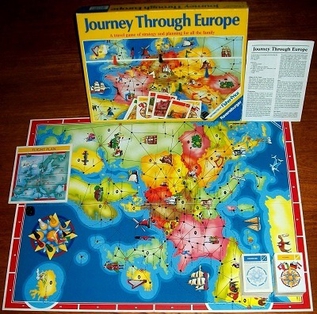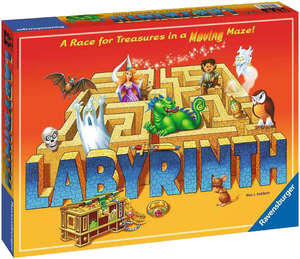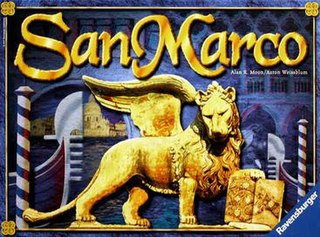 W
WEnchanted Forest is a board game designed by Alex Randolph and Michel Matschoss that requires players to remember the locations of fairytale treasures. The first edition of the game was published by Ravensburger in Germany in 1981 under the original name Sagaland.
 W
WFITS is a Tetris-like board game published by Ravensburger in 2009.
 W
WHare and Tortoise is a German-style board game designed by David Parlett in 1974 and first published by Intellect Games. In 1978 it was released by Ravensburger in Germany, where the game became a huge hit. It has since sold some 2 million units in at least ten languages, including several known pirated editions. The current edition is published by Gibsons Games in the UK, Ravensburger in Germany and Rio Grande Games in the United States.
 W
WHavannah is a two-player abstract strategy board game invented by Christian Freeling. It belongs to the family of games commonly called connection games; its relatives include Hex and TwixT. Havannah has "a sophisticated and varied strategy" and is best played on a base-10 hexagonal board, 10 hex cells to a side.
 W
WJava is a German-style board game designed by Wolfgang Kramer and Michael Kiesling and published in 2000 by Ravensburger in German and by Rio Grande Games in English. It is illustrated by Franz Vohwinkel.
 W
WJourney through Europe or Explore Europe is a family board game in which the players travel around a map of Europe, rolling a die to move. When they have reached all their objective cities, they try to return home to win.
 W
WLabyrinth is a board game for two to four players, published by Ravensburger in 1986.
 W
WMalefiz is a strategy board game, invented by Werner Schöppner and published by Ravensburger since 1960. It is a non-circular descendant of the ancient Indian board game Pachisi.
 W
WMexica is a board game designed by Wolfgang Kramer and Michael Kiesling and published in 2002 by Ravensburger in German and Rio Grande Games in English. Mexica was awarded 5th prize in the 2002 Deutscher Spiele Preis.
 W
WPueblo is an abstract strategy game which is a competition to optimally place blocks in a constrained space. The name, theme, and artwork for the game derive from the famous architecture of Taos Pueblo, but they are very lightly applied.
 W
WReversi is a strategy board game for two players, played on an 8×8 uncheckered board. It was invented in 1883. Othello, a variant with a change to the board's initial setup, was patented in 1971.
 W
WRivers, Roads & Rails is a matching game similar to dominoes, but with 140 square tiles and in some respects similar to Bendomino. The game consists of square card pieces featuring different coloured tracks. The game was created by Ken Garland and Associates and first published in 1969 under the name Connect. Since 1982 it has been produced by Ravensburger, first in an abstract form, and since 1984 under the current theme with artwork by Josef Loeflath. It has also been known under the name Contact.
 W
WRummikub is a tile-based game for 2 to 4 players, combining elements of the card game rummy and mahjong. There are 106 tiles in the game, including 104 numbered tiles and two jokers. Players have 14 or 16 tiles initially and take turns putting down tiles from their racks into sets of at least three, drawing a tile if they cannot play. In the Sabra version, the first player to use all their tiles scores a positive score based on the total of the other players' hands, while the losers get negative scores. An important feature of the game is that players can work with the tiles that have already been played.
 W
WSan Marco is a 2001 designer board game by Alan R. Moon and Aaron Weissblum. The game is set in Venice, and the title comes from the name of one of the city's districts. There are six districts across which players vie for influence. The games uses area control and card drafting as game mechanics. The game is divided into passages, which are then broken down into turns. Players can place and move both aristocrats and bridges, and score points for areas in which they have influence.
 W
WScotland Yard is a board game in which a team of players controlling different detectives cooperate to track down a player controlling a criminal as they move around a board representing the streets of London. It was first published in 1983. It is named after Scotland Yard - the headquarters of London's Metropolitan Police Service in real-life. Scotland Yard is an asymmetric board game, during which the detective players cooperatively solve a variant of the pursuit-evasion problem. The game is published by Ravensburger in most of Europe and Canada and by Milton Bradley in the United States. It received the Spiel des Jahres award in 1983 - the same year that it was published.
 W
WTake It Easy is an abstract strategy board game created by Peter Burley. It can be characterized as a strategic bingo-like game, and has been published by Ravensburger and subsequently by several other publishers since 1983. Each player gets a board with places for 19 hexagon tiles to place in a hexagon shape. Additionally, players get identical sets of tiles which have different types of colored/numbered lines crossing in three directions. One player draws a tile randomly and then tells the others which was drawn. Each player then puts their matching tile on their board in any available spot. This is repeated until the board is filled. The object is to complete colored/numbered lines across the board, for which points are scored according to the numbers on those lines. The maximum score possible is 307.
 W
WTikal is a German-style board game designed by Wolfgang Kramer and Michael Kiesling and published in 1999 by Ravensburger in German and by Rio Grande Games in English. The theme of the game is that of adventurers exploring parts of a Central American jungle in which artifacts and temples are discovered.
 W
WTop Secret Spies is a spy-themed German-style board game designed by Wolfgang Kramer and published in 1984 by Ravensburger. The game, also known as Under Cover or Detective & Co, won the Spiel des Jahres award in 1986.